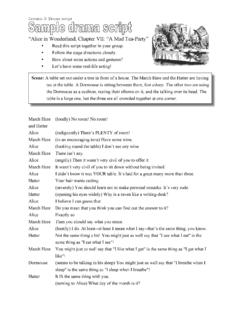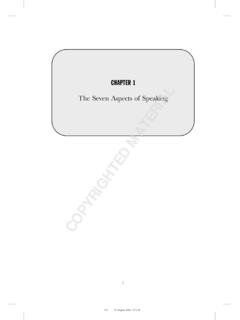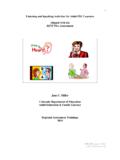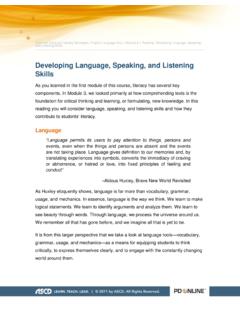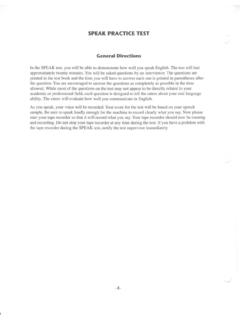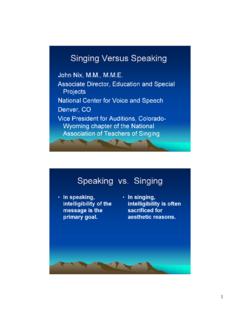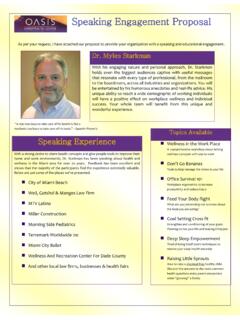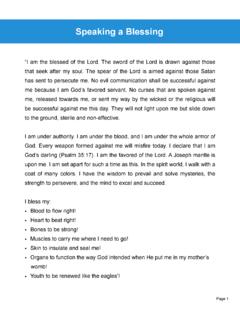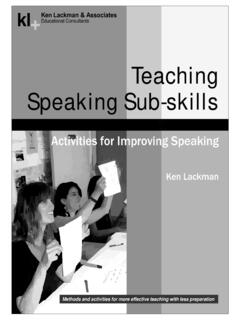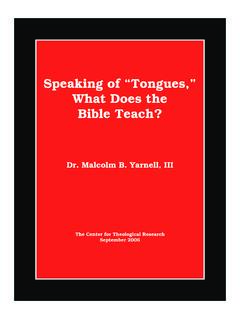Transcription of Compiled by David Holmes - Finchpark
1 speaking Activities for the Classroom Copyright 2004 Compiled by David Holmes .. 3 Contents Preface : To The Teacher Chapter One : Warm-up Activities Chapter Two : Words, Phrases and Sentences Chapter Three : Grammar and speaking Chapter Four : Interactive Role-Play Chapter Five : Traveling and Touring Chapter Six : Finding the Right Words Chapter Seven : Fables, Tales and Stories Chapter Eight : Talking Tasks Chapter Nine : A Bit of Business Chapter Ten : Pronunciation Chapter Eleven : How to Improve Your Diction Chapter Twelve : Sound and Rhythm Chapter Thirteen : More Pronunciation Practice Chapter Fourteen : Curriculum Development .. 4 Preface The materials in this text were Compiled over a period of ten years, in Thailand from 1993 to 2003, while I was teaching at The Faculty of Arts at Chulalongkorn University and later at the Department of Language at KMUTT.
2 I started a file of speaking activities because there were too many tasks and ideas to keep in my head, and I wanted to be able to access them when I needed them in the future. Eventually, the file grew thicker and thicker, until it was big enough to become a book. The speaking activities in this text come from a variety of sources: A lot of the tasks sprang from my own imagination, stimulating me to go into the classroom, feeling motivated by the freshness that accompanies a new inspiration and being eager to share it with my students. This could be compared to cooking on impulse rather than following a set recipe. I got many additional ideas from talking to fellow-teachers about what worked for them in their classes.
3 I even picked up some good examples from the handouts of various courses that I was required to teach, all of which taught me a lot of time-proven tricks that almost always work. Curiously, when I told my Chula students that I was compiling a collection of speaking tasks for publication, they responded by getting involved and suggesting ideas of their own. I would often divide the class into groups of five students and tell them to make up a dramatic scene or dialogue or game, or whatever else they wanted to try, and come back and perform it in the next class. Many of these activities were effective learning tools and have been included in the book. For many years, I also facilitated English programs for Arthur Andersen, SGV Na Thalang, KPMG, Yontrakit Group, Amari Group, and Bank of Ayuddya, TOT, DEP and TAT, and other organizations, in Thailand, for which I had to keep creating new materials, so that it has become second nature for me develop speaking activities for the classroom.
4 One final thing that I would like to add is that, at KMUTT, I learned a great deal about student-centered, self-access, task-based learning, and curriculum development, working with Richard Watson Todd of the Faculty of Applied Linguistics, so it follows that much of what you see in this book also illustrates the Theory and Practice of Curriculum Development as it was being created at that time in the International Program at KMUTT. David Holmes Bangkok, 2003 5To the Teacher This is a book for teachers and students who wish to create a classroom environment enjoyable for both students and teachers. With this idea in mind, I am going to summarize some prefatory comments I made at the opening of a Task-Based Learning and Curriculum Conference held at KMUTT in the year 2000.
5 We began with the question, Who is the most important person in the classroom? , and answered, The student is the most important person, because the university and the teacher are there to serve the student s need to learn, just as the hospital is there to treat the patients, or the police to protect the security of the citizens. Ironically, however, institutions can end up serving the purposes of those who run them so an imbalance is created that downplays the rights of those to be served. Teachers should always remember this and try to look at their classes from the student s point of view. In short, we need to do what the students need and not make them do what we need. Unfortunately, until the end of the twentieth century, classrooms in Thailand, and elsewhere throughout the world, were teacher- dominated and teacher-centered.
6 This is changing now, which is why the title of my talk at the conference was, Good Morning Class, Welcome to the Twenty-first Century. Let s look at what students of English as a foreign language need. First of all, they need to develop the four basic skills of listening, speaking , reading and writing, but they also need to practice in such skills in a way that makes them : Think independently Be creative Follow their inspiration and interest Learn what they want to know Learn how to find information Learn to do their own research Learn to report their findings Learn to present their ideas to others Learn to communicate conclusions Learn to take pride in their achievements Learn to develop personal responsibility And how to continue to develop said skills, 6in a way that will make them successful in their careers and lives.
7 Learn is something the student does for him/herself, while Teach is something the teacher does to the students. Nowadays in this age of progress the teacher has to come down from his pedestal at the front of the room to interact with the individuals in the class, on the level to use and English idiom. What should happen, then, is that they become partners in progress, and the students should show greater willingness to participate if they feel it is their class rather than the teacher s. The teacher should not have sole-ownership of the class. Instead, it should be a joint-venture in which the teacher helps the students in a constructive way to learn what they feel they need. This is certainly better than the old way of : Memorizing lists of facts Making ticks on multiple Choice sheets Following orders like cadets Showing no independence and No ability to think for themselves No ability to share in decision-making and No experience in sharing responsibility Instead of looking down on your students from a position of authority, you should look at your students as the hope of the future.
8 The new generation does not want to become a bunch of little robots, that are trained to follow orders and just do as they are told. They will obviously want to participate in the process life and social change in a constructive way. Before that can happen, teachers must change from being bureaucratic dictators to becoming benevolent helpers. The problem is that this will take courage. I don t know how many times I have been told : Follow the course syllabus exactly. Do only exercises in the prescribed text. Follow orders with no exception. Don t change anything. Don t do anything different. Don t try to be creative. Don t think for yourself. Don t do anything based on your own experience. Follow the department traditions.
9 7 Follow bureaucratic procedures. Don t break the rules. Don t deviate from the norm. Do things the way that we ve been doing them for the last forty years. Remember that we are a highly respected institution and that we are expected to adhere to traditional standards. What are teachers to do against being ordered about, in this way, like a bunch of pre-programmed automatons, within an out-dated system? The answer is to create a Task-Based Curriculum. The answer is to throw out the rulebook and start over. We should sit down in our departments and hammer out a new, task-based curriculum more-suited to the needs of present day society, based on activities that encourage independent development. The cornerstones of student-centered learning are as follows : Task-based learning means helping the students choose a job that they want to do and then let them go out and do it, individually, on their own or within peer-learning a group.
10 Student-centered learning means allowing the students the freedom to work on topics of their own choosing, within reasonable guidelines, in accordance with the body of knowledge. Self-access learning means letting the students go out and find their own information on their topics from anywhere they can, such as the Internet, books, journals, magazines, newspapers, interviews, and etc. Group Activities means allowing the students to form groups of four or five in which they will share the responsibility of getting-the-job-done and of doing the planning, preparation and presentation of their accumulated information as a team, each with an assigned task to fulfill, so they can learn from working with others and from the constructive comments the teacher makes in helping them through the steps of the process.
